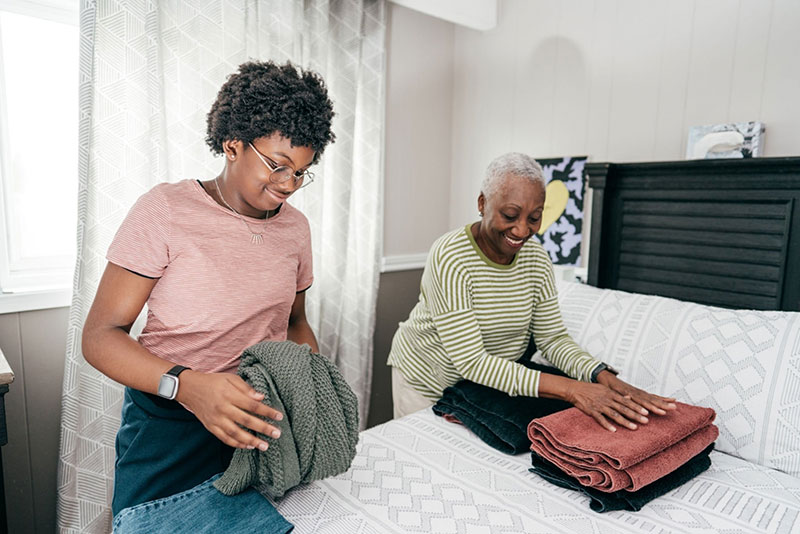Due to recent medical advancements and healthier lifestyles, Americans are living longer than ever. Consequently, our society is experiencing a dramatic increase in the number of older adults—an unprecedented trend with profound impacts on the healthcare industry.
The Baby Boomer generation—those born between 1946 and 1964—currently makes up the largest segment of our population, creating what Bloomberg News recently dubbed a “Silver Tsunami” crisis. A predicted 25% increase in the over-65 population could stretch traditional eldercare resources, such as nursing homes and assisted living facilities, to their limits. As this wave of retirees reaches a stage of life where daily health and wellness assistance may become necessary, finding home care solutions has become the new frontier for Baby Boomers.
How Aging in Place Preserves Comfort And Dignity
As of July of 2023, approximately 1.2 million Americans were living in nursing homes—a 12% decrease since 2015. Given the unique challenges presented by both the Silver Tsunami crisis and the global COVID-19 pandemic, the eldercare industry is facing a significant shift toward aging in place—i.e. individuals receiving care in the comfort of their own homes. Though at-home care was a situational requirement for many during the pandemic, a 2024 survey shows that the majority of today’s Baby Boomers would prefer to age in place.
There are many benefits to at-home care, especially considering one’s emotional attachment to their own home and the many stressors of moving. Aging in place empowers individuals to continue living in their preferred environments, maintaining the familiar atmosphere curated throughout their lives. This preservation of security and individuality can be especially important for dementia patients, who often rely on familiar surroundings and routines as anchors in their daily lives. Given the unique challenges that come with aging—including what may feel like a decrease in agency, and therefore an aversion to change—receiving care in one’s own home can be essential for preserving one’s dignity, comfort and overall quality of life.
Fostering a Safe And Trusting Environment in The Home
Receiving care in the comfort of home isn’t just great for peace of mind; it’s also beneficial for one’s safety. Unfortunately, the aging population is often a vulnerable one, especially when individuals are isolated from their loved ones. Older adults are especially susceptible to various forms of mistreatment, including physical, emotional, and financial exploitation, which is classified as elder abuse. In 2013, the National Center for Victims of Crime revealed that around 25% of nursing home residents experienced physical abuse, nearly 20% underwent emotional and psychological abuse and just over 15% suffered neglect.
Family caregivers offer a viable and compassionate alternative to nursing homes and assisted living facilities, minimizing the risk of neglect and/or abuse by ensuring that loved ones are directly involved in daily care and decision-making.
Family members are often well-positioned to advocate for their loved ones when they cannot advocate for themselves, ensuring that their rights are protected and they receive the appropriate level of care. What’s more, trust can often be a barrier for treatment when it comes to elderly individuals; having a trusted caregiver who is intimately familiar with their loved one’s needs can help foster a more effective, personalized care experience.
Family Caregiving as The Antidote to Isolation
Loneliness is a growing epidemic in America, particularly among older adults. The National Library of Medicine notes that loneliness in nursing homes affects a whopping 40% of residents, likely due to the transition away from familiar spaces and social networks. It’s true that even older adults who age in place may experience loneliness, but shared living arrangements— where older adults live with relatives or friends—effectively mitigates feelings of isolation.
According to AARP, 69% of older adults are more than willing to share their homes with family members or friends as they age. These kinds of caregiving arrangements aren’t just logistically convenient; they allow aging patients to maintain close personal connections, a proven key to healthy aging. Family caregivers not only empathize with their aging loved ones, but they also help aging adults feel a sense of normalcy. Rather than feeling like they are being cared for by a stranger intruding on their home, aging adults may instead feel comforted by spending quality time with a loved one who understands and appreciates their needs.
As we continue to navigate the Silver Tsunami, it’s crucial that we adapt to meet the physical and emotional needs of our aging Baby Boomers. When considering the benefits of comfort, safety, trust and companionship, at-home family caregiving stands out as the most compassionate and innovative solution. By combining smart, personalized healthcare with unparalleled family support, we can empower our loved ones to remain independent for years to come.
Evan Ostrovsky is the chief executive officer and executive director of Special Touch Home Care in Brooklyn.




